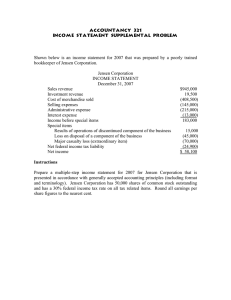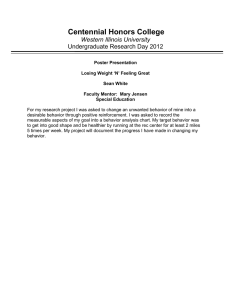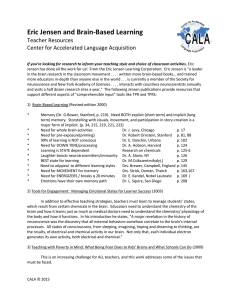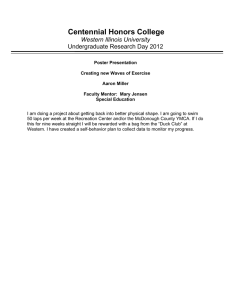8 Human Development A Cultural Approach Adolescence
advertisement
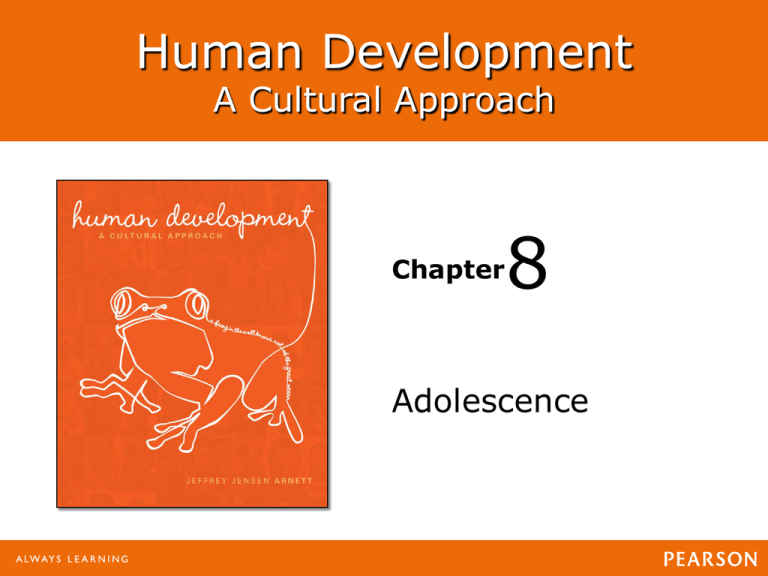
Human Development A Cultural Approach Chapter 8 Adolescence Human Development: A Cultural Approach Jeffrey Jensen Arnett Physical Development Human Development: A Cultural Approach Jeffrey Jensen Arnett Biological Changes of Puberty The Physical Changes of Puberty • Puberty is a time period of rapid biological growth • Hormonal changes associated with percentage of body fat • Estrogen—estradiol production 8 times higher in females • Androgens—testosterone is 20 times higher in males Human Development: A Cultural Approach Jeffrey Jensen Arnett Biological Changes of Puberty The Physical Changes of Puberty Human Development: A Cultural Approach Jeffrey Jensen Arnett Biological Changes of Puberty The Physical Changes of Puberty • Primary sex characteristics—directly related to reproduction • Secondary sex characteristics—other bodily changes due to hormonal increases • Girls experience menarche (first menstrual period) • Boys experience spermarche (first ejaculation) Human Development: A Cultural Approach Jeffrey Jensen Arnett Biological Changes of Puberty The Physical Changes of Puberty Human Development: A Cultural Approach Jeffrey Jensen Arnett Biological Changes of Puberty The Physical Changes of Puberty • Exuberance and synaptic pruning Especially concentrated in the frontal lobes • Myelination encourages efficiency in thought • Cerebellum continues to grow Human Development: A Cultural Approach Jeffrey Jensen Arnett Biological Changes of Puberty Timing of Puberty • Girls begin puberty about two years earlier than boys • Cultural differences Kikuyu—boys show puberty before females Chinese—girls develop pubic hair before breast buds (counter to Western pattern) African American—girls develop breast buds and pubic hair earlier than white girls Human Development: A Cultural Approach Jeffrey Jensen Arnett Biological Changes of Puberty Timing of Puberty • Technology in food production and medical care influence puberty • Age of menarche has decreased in Western countries • Average age of menarche is lowest in industrialized countries In rapidly developing countries a decline is seen in recent decades after development Human Development: A Cultural Approach Jeffrey Jensen Arnett Biological Changes of Puberty Timing of Puberty Human Development: A Cultural Approach Jeffrey Jensen Arnett Biological Changes of Puberty Timing of Puberty • Early maturation Girls—depressed mood, negative body image, eating disorders Boys—favorable body image, higher popularity, earlier delinquency • Later maturation may be more negative for boys with fewer problems for girls Human Development: A Cultural Approach Jeffrey Jensen Arnett Physical Development Puberty Rituals • Puberty rituals mark a transition • Girls Menstrual blood may be considered dangerous to crops, livestock, and people • Boys May be required to show feats of courage, strength, or pain endurance • Circumcision Human Development: A Cultural Approach Jeffrey Jensen Arnett Health Issues in Adolescence Eating Disorders • Anorexia Inability to maintain body weight Fear of weight gain Lack of menstruation Distorted body image Human Development: A Cultural Approach Jeffrey Jensen Arnett Health Issues in Adolescence Eating Disorders • Bulimia Fear of weight gain Engage in binge eating then purge Can damage teeth from repeated vomiting • Tend to maintain normal weight and recognize abnormal eating patterns • Eating disorders are more common in cultures that emphasize slimness Human Development: A Cultural Approach Jeffrey Jensen Arnett Health Issues in Adolescence Eating Disorders • Treatment options: hospitalization, medication, or psychotherapy • Effectiveness: 1/3 of individuals treated for anorexia remain ill 1/2 of individuals treated for bulimia relapse Continuing problems as individuals dealing with these disorders age Human Development: A Cultural Approach Jeffrey Jensen Arnett Health Issues in Adolescence Substance Use • Reasons for substance use among adolescents are varied Experimental Social Medicinal Addictive Human Development: A Cultural Approach Jeffrey Jensen Arnett Cognitive Development Human Development: A Cultural Approach Jeffrey Jensen Arnett Piaget’s Formal Operations Hypothetical Deductive Reasoning • Hypothetical Deductive reasoning • Pendulum problem Human Development: A Cultural Approach Jeffrey Jensen Arnett Piaget’s Formal Operations Critiques • Individual differences Not seen in every instance of teen life Adolescents with math and science exhibit it more • Cultural differences Traditional Piagetian tasks show little success Success if task relevant to culture Human Development: A Cultural Approach Jeffrey Jensen Arnett Information Processing Attention and Metamemory • Adolescents improve on attention tasks Selective attention—focus on relevant information Divided attention—two things at once but learning is still detrimentally effected • Memory also improves Use of memory strategies (mnemonic devices) Experience and knowledge is enhancing Human Development: A Cultural Approach Jeffrey Jensen Arnett Social Cognition: Imaginary Audience and Personal Fable • Adolescent Egocentrism has two aspects Imaginary audience - Leads to feeling of self-consciousness Personal fable - Can lead to anguish and high risk behavior Human Development: A Cultural Approach Jeffrey Jensen Arnett Cognitive Development Culture and Cognition Lev Vygotsky •Zone of Proximal Development •Scaffolding Vygotsky’s Zone of Proximal Development Human Development: A Cultural Approach Jeffrey Jensen Arnett Emotional and Social Development Human Development: A Cultural Approach Jeffrey Jensen Arnett Emotional and Self-Development Storm and Stress • Adolescence thought to be a time of storm and stress • Experience Sampling Method (ESM) has shown that In U.S. it is a time of emotional volatility Self-conscious, embarrassed, moody, lonely, and nervous Human Development: A Cultural Approach Jeffrey Jensen Arnett Emotional and Self-Development Storm and Stress • Source of distress a combination of cognitive and environmental factors • Transitions coupled with how events are interpreted contribute to volatility Human Development: A Cultural Approach Jeffrey Jensen Arnett Emotional and Self-Development Storm and Stress Human Development: A Cultural Approach Jeffrey Jensen Arnett Emotional and Self-Development • Adolescent self—conceptions become complex • Composed of: Actual self—true self conception Possible self—what you could become - Ideal self—would like to be - Feared self—possible to become but fears becoming it False self—what is shown to others Human Development: A Cultural Approach Jeffrey Jensen Arnett Emotional and Self-Development • Discrepancy between actual self and ideal self can lead to feelings of failure and depression • Self-esteem tends to fluctuate during adolescence Human Development: A Cultural Approach Jeffrey Jensen Arnett Emotional and Self-Development Self-Esteem Human Development: A Cultural Approach Jeffrey Jensen Arnett Emotional and Self-Development Self-Esteem • Self-esteem composed of many dimensions • Susan Harter investigated eight domains of influence on adolescent self-image Human Development: A Cultural Approach Jeffrey Jensen Arnett Emotional and Self-Development Self-Esteem • Domains of importance to most adolescents are: Physical appearance Social acceptance • Tend to effect self-esteem the most especially in girls Human Development: A Cultural Approach Jeffrey Jensen Arnett Emotional and Self-Development Gender Intensification • Gender intensification hypothesis— psychological and behavioral differences more pronounced from childhood to adolescence due to increased pressure to conform to gender roles Human Development: A Cultural Approach Jeffrey Jensen Arnett Emotional and Self-Development Gender Intensification • Research has been shown to support hypothesis • From 6th–8th grade boys and girls selfdescriptions became more gender stereotyped Human Development: A Cultural Approach Jeffrey Jensen Arnett Emotional and Self-Development Gender Intensification • Gender intensification higher in traditional cultures • Boys Achieve manhood by providing, protecting, and procreating • Girls Demonstrate womanhood but it is inevitable and cannot fail Human Development: A Cultural Approach Jeffrey Jensen Arnett Cultural Beliefs Moral Development • Kohlberg proposed a universal theory of moral development • His focus was on the structure of moral reasoning Human Development: A Cultural Approach Jeffrey Jensen Arnett Cultural Beliefs Moral Development • Classified moral reasoning into three levels composed of two stages each Preconvention—likelihood of rewards and punishments Conventional—value conforming to moral others Post conventional—objective principles of right and wrong Human Development: A Cultural Approach Jeffrey Jensen Arnett Kohlberg’s Stages of Moral Development Preconventional Conventional Postconventional • Stage 1Punishment and obedience • Stage 2Individualism and purpose • Stage 3Interpersonal Concordance • Stage 4- Social Systems • Stage 5Community Rights • Stage 6Universal Ethics Human Development: A Cultural Approach Jeffrey Jensen Arnett Cultural Beliefs Moral Development • Alternate view of moral reasoning focuses on the individual’s worldview • World view provides basis for: Moral reasoning—explaining right or wrong Moral evaluations—outcome of moral reasoning Moral behaviors—actions that reinforce world view Human Development: A Cultural Approach Jeffrey Jensen Arnett Cultural Beliefs Moral Development Human Development: A Cultural Approach Jeffrey Jensen Arnett Cultural Beliefs Religious Beliefs • Adolescents in industrialized societies are less religious than traditional cultures • Religion has a low priority and tends to follow no specific traditional doctrine Human Development: A Cultural Approach Jeffrey Jensen Arnett Cultural Beliefs Religious Beliefs Human Development: A Cultural Approach Jeffrey Jensen Arnett Cultural Beliefs Religious Beliefs • Differences in religiosity include: Family characteristics Ethnicity • Religious involvement provides protective factors Human Development: A Cultural Approach Jeffrey Jensen Arnett Social and Cultural Contexts of Development Family Relationships • Conflicts with parents increase • May be due to sexual maturation, cognitive issues, and greater independence and autonomy Human Development: A Cultural Approach Jeffrey Jensen Arnett Social and Cultural Contexts of Development Family Relationships • Sibling relationships have conflict but less than in earlier childhood • Traditional cultures Siblings have child care responsibilities Close to extended family members • More contact in traditional cultures than Western countries Human Development: A Cultural Approach Jeffrey Jensen Arnett Social and Cultural Contexts of Development Peers and Friends • Friends provide companionship and intimacy • In traditional cultures adolescents spend more time with family than peers • Intimacy most distinctive feature of adolescent friendships Human Development: A Cultural Approach Jeffrey Jensen Arnett Social and Cultural Contexts of Development Peers and Friends • Girls talk more with their friends than boys • Non-Western countries adolescents are close to families even as they are close to friends Human Development: A Cultural Approach Jeffrey Jensen Arnett Social and Cultural Contexts of Development Peers and Friends • Adolescent social groups include: Cliques—small group of friends Crowds—larger reputation based and not necessarily friends - Elites, athletes, academics, deviants, and others • Crowds help adolescents define their own identities Human Development: A Cultural Approach Jeffrey Jensen Arnett Social and Cultural Contexts of Development Peers and Friends • Bullying composed of three components: Aggression—physical or verbal Repetition—pattern over time Power imbalance—higher peer status • Negative effects include helplessness, anxiety, and unhappiness • Cyber bulling has highest rates in early adolescence Human Development: A Cultural Approach Jeffrey Jensen Arnett Social and Cultural Contexts of Development Love and Sexuality • Romantic relationships increase over time • Asian cultures later than other groups • Romance is less formal than previous years Human Development: A Cultural Approach Jeffrey Jensen Arnett Social and Cultural Contexts of Development Love and Sexuality • Relationships and sexuality are viewed differently due to culture Permissive cultures tolerate sexuality Semi restrictive cultures have prohibitions Restrictive cultures have strong prohibitions Human Development: A Cultural Approach Jeffrey Jensen Arnett Social and Cultural Contexts of Development Pregnancy • Pregnancy and contraception use vary by type of country • Permissive adolescent sex attitudes— low rates of conception Influenced by availability and attitudes about safe sex and contraception Human Development: A Cultural Approach Jeffrey Jensen Arnett Social and Cultural Contexts of Development Pregnancy • Restrictive adolescent sex attitudes— low rates of conception Influenced by discouraging attitudes • United States high rate impacted by mixed messages Human Development: A Cultural Approach Jeffrey Jensen Arnett Social and Cultural Contexts of Development Sexual Orientation • Adolescence is when sexual orientation is fully aware Historically kept secret now more likely to “come out” Homophobia can make coming out traumatic Parental rejection a concern Acceptance by peers may be increasing Human Development: A Cultural Approach Jeffrey Jensen Arnett Social and Cultural Contexts of Development Schools • International variations • School types Comprehensive Schools Non-Comprehensive Schools • Enrollment Developed countries is the norm Developing countries it is difficult - Gender differences and rising enrollments but insufficient funding and lack of teachers Human Development: A Cultural Approach Jeffrey Jensen Arnett Social and Cultural Contexts of Development:Work • Developing countries Prostitution on rise especially in Asia - Many ways it can occur • Developed countries Not related to family support Could negatively impact development Increased hours could lower grades Human Development: A Cultural Approach Jeffrey Jensen Arnett Social and Cultural Contexts of Development Work Human Development: A Cultural Approach Jeffrey Jensen Arnett Social and Cultural Contexts of Development Work • European countries have tradition of apprenticeship • Common in central and northern Europe Entry at age 16 Continued part time schooling Training that takes place in workplace Preparation for a career in a respected profession Human Development: A Cultural Approach Jeffrey Jensen Arnett Social and Cultural Contexts of Development Media Use Human Development: A Cultural Approach Jeffrey Jensen Arnett Social and Cultural Contexts of Development Media Use • Electronic games Become more popular amongst boys Favorite games involve violence Could be related to anxiety and depression Use may be related to feelings of power, fame, and dealing with stress Human Development: A Cultural Approach Jeffrey Jensen Arnett Problems and Resilience Crime and Delinquency • Crime rates peak about 18 then decline • Age-crime relationship Increased peer importance coupled with independence from parents • Two types of delinquency Life course—persistent delinquents Adolescence limited delinquents Human Development: A Cultural Approach Jeffrey Jensen Arnett Problems and Resilience Crime and Delinquency Human Development: A Cultural Approach Jeffrey Jensen Arnett Problems and Resilience Depression • Types of depression Depressed mood Depressive syndrome Major depressive disorder • Two types of treatment Anti-depressant therapy Cognitive behavior therapy Human Development: A Cultural Approach Jeffrey Jensen Arnett Problems and Resilience Resilience in Adolescence • Resilience—good outcomes in spite of threats to adaptation and development • Protective factors are: High intelligence Effective parenting Adult mentor High self-regulation Ethnic identity (minorities) Religiosity Human Development: A Cultural Approach Jeffrey Jensen Arnett

